.jpg?w=500&h=918)
Saturn Devouring My Son" is a painting by Spanish artist Francisco de Goya, one of a series of "Black Paintings.
The shocking title of the painting, as well as the title and visuals that directly express its content, make it an unforgettable work.
Basic Information on "Saturn Devouring My Son
Author: Francisco de Goya
Year: 1819-1823
Material: oil on canvas
Dimensions: 146 cm x 83 cm
Collection: Museo del Prado, Madrid
What is the Myth of Saturn? The Story Behind the Painting
This painting by Goya was based on a mythological theme.
The painting depicts the legend of Saturn, the god of agricultural fertility in Roman mythology (equivalent to Cronus in Greek mythology), who, fearing a prophecy that his children would kill him in the future, swallowed his five children one by one.
In Roman mythology, he was originally king of Mount Olympus, the home of the gods, but after Zeus took his throne, he moved to Italy. Legend has it that he introduced agricultural technology to Italy and civilized the country.
However, in his old age, Saturn became obsessed with insanity out of fear of his own destruction.
Instead of swallowing his own child whole, as in the legend, he bites and devours it from the head down, depicting it with realism.
Many viewers are disgusted by the grotesque realism of the depiction.
At the same time, however, the directness of the depiction has made it a rare masterpiece in the history of art.
Uniqueness of Goya's Paintings
Hidden Sexuality
In its original state, the painting is said to have depicted Saturn's erect penis.
The depiction of Saturn as if he were a sexual pervert who becomes sexually aroused at the time of his murder is a significant departure from the original myth, and reflects the artist's pessimistic view of the world and his unique view of human nature in his later years.
Rubens' "Saturn Devouring My Son
Incidentally, this work was painted when Goya was 77 years old, but about 200 years before this work, the Dutch painter Rubens painted "Saturn Devouring His Own Son," based on the same folklore.
Compared to Rubens' Saturnus, Goya's Saturnus looks like a monster or a giant instead of a man, and the pitch-black background adds to the sense of dread.
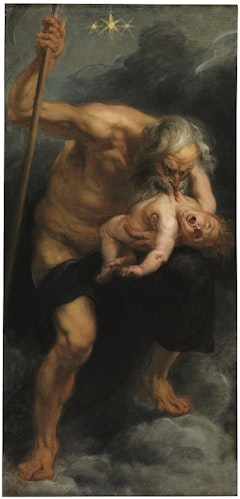
Pieter Paul Rubens, Saturn devouring his own child, 1636-1638
Goya's "Giants" are
Although Saturn is depicted as if he were a gigantic monster, "giants" were actually a recurring motif in Goya's paintings.
_cropped.jpg?w=400&h=491)
Untitled, etching, 1814-1818
The images of giants he left behind in prints and oils symbolize the desire for a colossal presence that would destroy the overall gloomy Spanish atmosphere of the time.
In her article "Artistic Techniques as a Method of Research on Goya's 'Giants'" (Goya Journal №324), critic Jesús Vega explains the following.
The Giant reflects the mood of many Spaniards as they move from resistance, defense, pride, and determination to depression, a collective emotion shared by the artist.
.jpg?w=400&h=488)
The Sleeping Giant, pencil lithograph, 1824-1828
What is a "black painting?"
The " Black Paintings," which include "Saturn Devouring His Son," are a series of paintings that Goya created on the walls of his home in the last years of his life.
They are called "Black Paintings" because many of the paintings have black as their main theme.
In his later years, Goya lost his hearing, and moreover, the house where the "Black Paintings" were painted was also called the "House of the Deaf" because a deaf person had lived there before Goya.
Below is a diagram of the arrangement of the paintings in the house.
The paintings in the "Black Paintings" are covered with a depressing atmosphere, and many of them are meaningful and enigmatic with mythological motifs.

Source
Other paintings in the "Black Paintings" series
Let's take a look at not only "Saturn" but also other "Black Paintings" one by one.
"The Fate of the Goddesses".
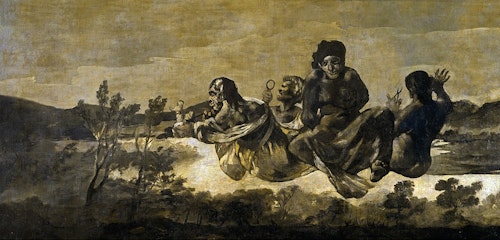
This painting was located on the second floor of the "House for the Deaf.
There are four mysterious figures, neither male nor female, floating in the air.
The foremost figure's hands are tied behind its back. It is as if they are prisoners. This may represent a fate that cannot be resisted.
The colors of this painting are dominated by ochre and black, as much or more so than in the other black paintings.
As befits a mythological subject, it reinforces the unrealistic atmosphere of night. Goya's "Black Paintings" are considered the forerunners of modern art in their depiction of absurdity.
The Witches' Nocturne

The Witches' Nocturne is a painting that deals with themes of violence, intimidation, aging, and death.
It depicts the moonlit silhouette of a giant Satan in the form of a goat over a congregation of terrified witches.
Some have suggested that this eerie assembly is a mockery of the superstitious and overzealous religious rituals of the Inquisition and witch trials that were practiced in 19th century Spain.
One can also sense the atmosphere of mental and physical pain that afflicted Goya in his old age.
Duel with the Cudgel
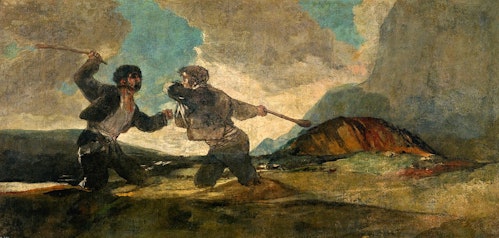
This painting depicts two men fighting with clubs while knee-deep in a mire of mud and sand.
One view suggests that the two men are fighting because they are incited to discord by a ruler, an ironic reference to the politics of King Ferdinand VII of Spain at the time.
Two old men eating a meal
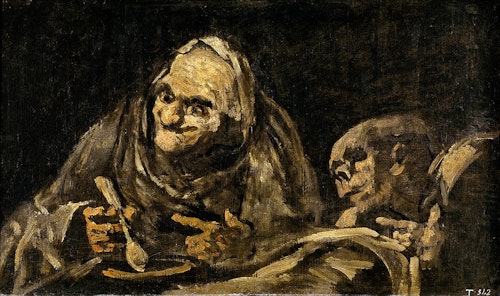
The two old men are commonly thought to be men, but this is not certain.
The man sitting on the left, scooping up something from a plate with a spoon, looks as if he is grinning.
In contrast, the figure on the right looks almost skeletal. Depressed eye sockets, bald head and nose.
Goya may have been superimposing himself on these two old men, who almost seem to be on their deathbeds.
In terms of technique, the entire painting is executed with bold strokes typical of Goya, and a painting knife is also used in some places. The speedy manner in which the form of the painting is determined with a single brushstroke is also common to later impressionist paintings.
Asmodeus
.jpg?w=500&h=231)
In this painting, two figures, a man and a woman, are depicted as if they are floating above a wide landscape.
They are each looking in opposite directions, but he is pointing to the town on the mountain on the right side of the canvas.
Critic Evan Connell has noted that the shape of the mountain resembles Gibraltar, which was a refuge for Spanish liberals after the Peninsular War.
It is thought that it may have a meaning that alludes to the situation in Spain at that time.
Pilgrimage to San Ysidro

This painting depicts people drunkenly singing with distorted faces.
The figures depicted here are from various social classes. In the foreground is a group of people of modest means, and in the background we see an upper class person wearing a hat and a nun.
The procession of the crowd, which even looks like a single living organism, was a recurring motif in Goya's paintings. It is said that this motif depicts his criticism of individuals becoming grouped together and taking on an inhuman quality.
The unique facial expressions and limited number of colors in this painting are said to be a precursor to the Belgian Expressionist painter James Ensor.
Dog in the Sand
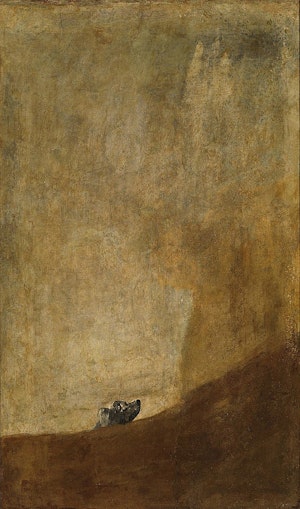
This painting is divided into two uneven sections: a rough ochre "sky" at the top and a small, sloping, curved dark-brown "slope" that darkens as it slopes upward to the right.
From the slope of the hill, a dog lifts its snout and looks upward, its head only peeking out.
In addition, right next to it, a dim, hazy, dark shape seems to loom over the dog. These faint shadows are thought to be the transparent remnants of another painting that was done on the same wall before "Dog in the Sand" was painted.
Art critic Robert Hughes said, "I don't know what this painting means, but its pathos moves us to a lower level of the story.
The Two Old Men.
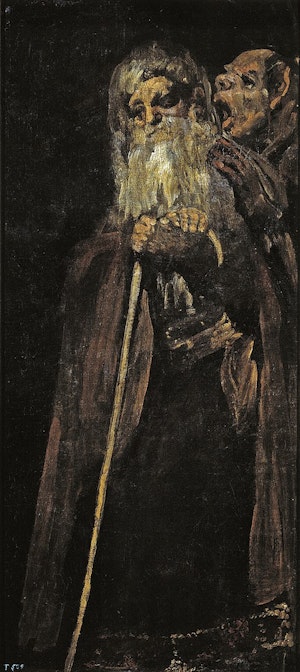
In this painting, an old man dressed as a monk is depicted on the full length of the painting, flanked by a man who appears to be overhearing him.
The figure beside him with his mouth open is depicted with a very caricatured expression, which is said to suggest Goya's deafness.
It is thought to be the embodiment of the image of his own deafness and others screaming noisily at him, an image that caused him mental anguish.
Reading

There are various theories as to who these people are, but one theory is that they are politicians confirming their reputations in the newspapers.
Recent X-ray analysis has shown that a completely different design is hidden beneath the painting, indicating that it was painted once and then boldly redrawn.
This painting is similar in size, setting, and composition to another "black painting" called "Two Women Mocking a Masturbating Man," and is considered a sister painting.
Judith and Holofernes.
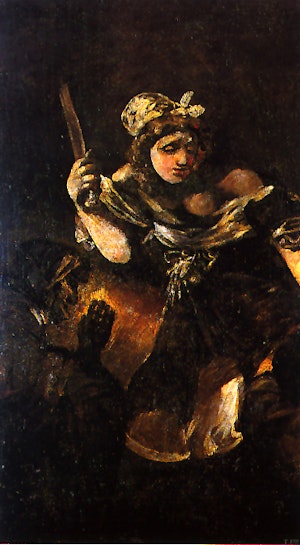
This theme, taken from the story in the Book of Judith, depicts Judith seducing Holofernes and cutting off his head.
It is one of the few figures in the Black Paintings to be explicitly taken from a past myth.
In the lower left corner, the figure of an elderly woman praying is outlined by a faint light.
Two Women Mocking a Masturbating Man
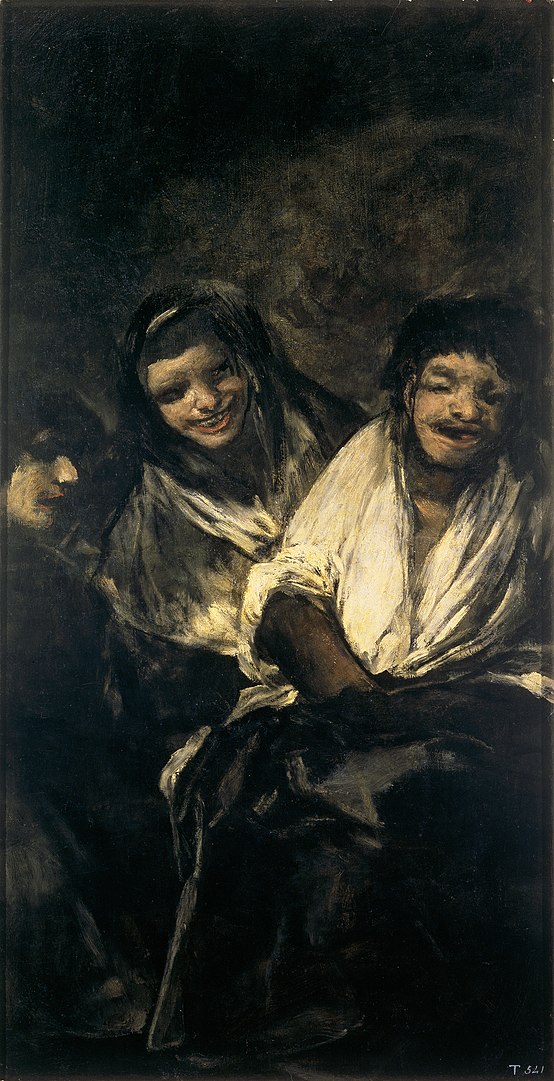
The intent of this work is very unclear.
There is no setting or detail in the background, and no context is given as to who these people are, what they are doing, or where the scene is set.
It is not clear from the depiction whether the man on the right side of the screen is really masturbating, but according to art critic Fred Licht, "the morbid smile on his face certainly indicates some sort of sexual obsession.
The two women are believed to be prostitutes.
He was crudely dispassionate and realistic when depicting people as they really are. However, when depicting sexual scenes, he was often crude and reserved.
Pilgrimage to the Fountain of San Isidro
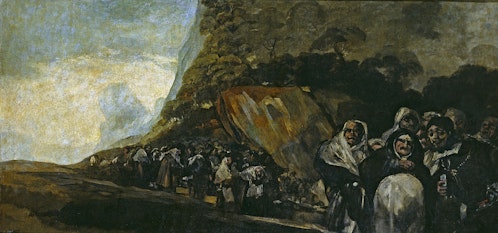
This painting, depicting a group of pilgrims, is one of the brightest of the "black paintings.
This painting, which also shares similarities with "Pilgrimage to the Fountain of San Isidro," is characterized by the presence of more nuns in the foreground.
Incidentally, the name "San Isidro" is thought to be closely related to the Spanish "Quinta del Sordo," which sounds quite similar to the "House for the Deaf," the house in which the "Black Paintings" were painted.
Leocadia.
.jpg?w=500&h=567)
This painting depicts Leocadia Weiss, Goya's maid, friend, and (possibly) lover.
She is dressed in dark clothing, like a funeral maja, and is leaning against what appears to be a mantelpiece or tomb, casting a sad gaze.
Leocadia is the last of the "Black Paintings.
The artist, Juan José Junquera, wrote that the work is the personification of melancholy, or the relationship between painter and model, "a symbol of the flames of love, domesticity, and the anticipation of death to come.
TRiCERA ART members receive a variety of benefits and preferences.
- Discounts, including members-only secret sales and coupons
- Create My Collection by registering your favorite artists
- Receive updates on popular artists, exhibitions, and events
- Receive a weekly newsletter with selected art
- Personal Assessment to find out what kind of art you like.
Please register as a member for free and receive the latest information.
Free Member Registration
For inquiries about our artwork, please contact us here.
If you have any questions about TRiCERA, please feel free to contact us through our official LINE.